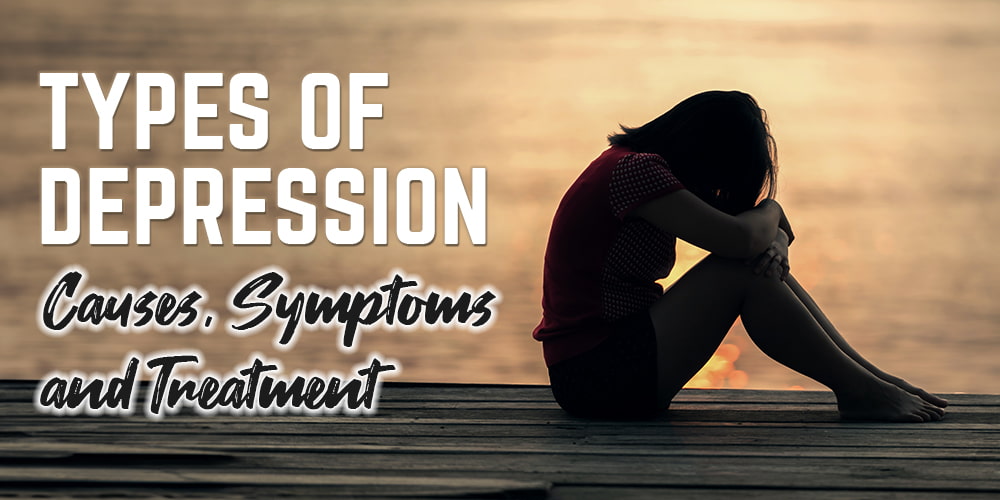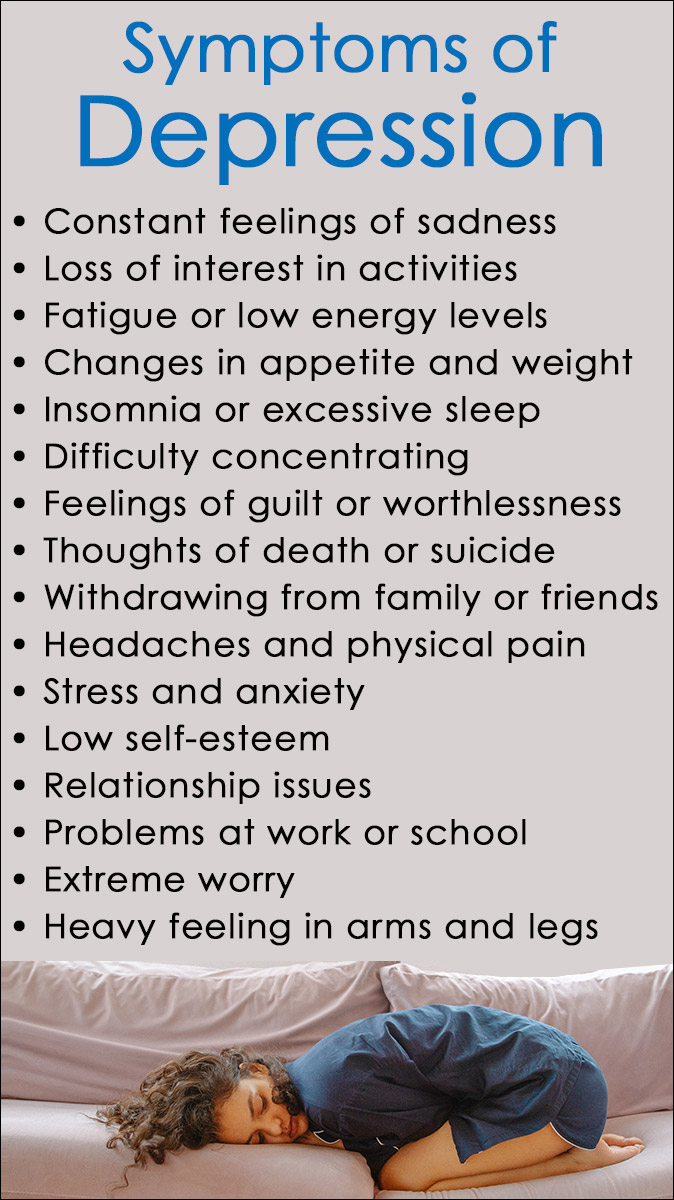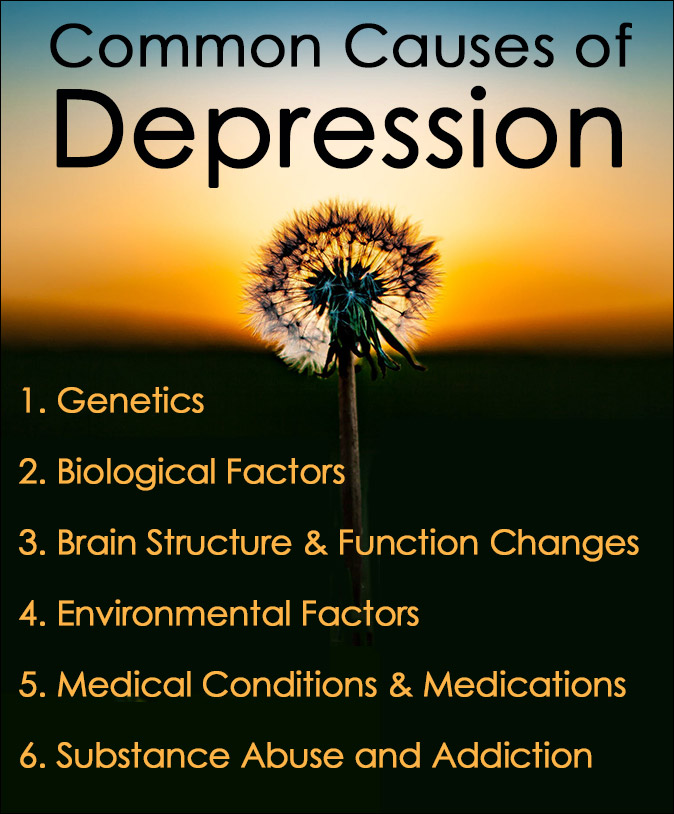
Depression is a mental health condition characterized by feelings of sadness, hopelessness, and a loss of interest in activities once enjoyed. There are different types of depression and each one has unique depressive symptoms, causes, and treatment methods.
The symptoms of depression go beyond normal fluctuations in mood and often have a significant impact on a person’s thoughts, behavior, and overall functioning.
A person with depression may experience a range of depressive symptoms such as fatigue, changes in appetite, sleep patterns, difficulty concentrating, feelings of worthlessness, and sometimes thoughts of self-harm or suicide.
There are numerous causes of depression, including genetic, biological, environmental, and psychological factors.
It is a serious medical condition that often requires professional depression treatment and support for a successful recovery.
7 Common Types of Depression
When considering the various types of depression, it’s necessary to receive a proper diagnosis by a medical professional that will recommend the appropriate form of treatment.
Over the years, some of the names or categories for certain types of depression have changed, especially when examining the differences between the DSM-IV and DSM-5 descriptions.
Here are 7 of the Most Common Types of Depression
1. Major Depressive Disorder (MDD)
Major Depressive Disorder (MDD) is also known as Clinical Depression, and it is the most common and severe form of depression.
MDD manifests through prolonged periods of low mood, lack of interest in normal activities, and a variety of physical and mental symptoms.
The National Institute of Mental Health estimates that 21.0 million adults (8.4% of the adult population) in the U.S. had a major depressive episode in 2020.
2. Persistent Depressive Disorder (PDD)
Persistent Depressive Disorder (PDD) was previously referred to as Dysthymia, and it involves long-lasting depressive feelings that persist for two or more years.
Although persistent depressive disorder is less severe than MDD, the depressive symptoms still have a significant impact on mental health and daily living.
3. Seasonal Affective Disorder (SAD)
Seasonal Affective Disorder (SAD), often called Seasonal Depression, is a type of depression that generally occurs during specific seasons, usually in the winter. It is mainly caused by reduced exposure to sunlight.
Seasonal Depression symptoms typically include decreased energy levels, an increase in the number of hours of sleep, weight gain, and an overall sense of sadness.
4. Postpartum Depression (PPD)
Postpartum Depression (PPD) is a specific type of depression that affects new mothers within the first year after childbirth.
PPD is influenced by hormonal changes during childbirth, sleep deprivation, as well as the mental and physical challenges of motherhood. It can lead to extreme sadness, anxiety, and general fatigue.
5. Bipolar Disorder
Bipolar Disorder is characterized by severe mood swings that include depressive episodes, sometimes called bipolar depression.
There are four main types of Bipolar Disorder and individuals with the condition experience alternating periods of elevated mood (mania) and depression.
6. Psychotic Depression
Psychotic Depression is a type of depression that is also recognized as major depression with psychotic features or psychosis.
Depression with psychosis is a combination of depressive symptoms along with psychotic features like hallucinations or delusions.
7. Premenstrual Dysphoric Disorder (PMDD)
Premenstrual Dysphoric Disorder (PMDD) is a severe and debilitating form of premenstrual syndrome (PMS) that affects a small percentage of individuals who menstruate.
PMDD is characterized by physical and emotional symptoms that occur in the week or two before menstruation and impact a person’s daily functioning and quality of life.
Unlike typical PMS symptoms, Premenstrual Dysphoric Disorder produces more intense mood swings, irritability, sadness, anxiety, and a loss of interest in usual activities.
Physical symptoms like bloating, breast tenderness, fatigue, and changes in appetite may also be experienced.
PMDD is a distinct condition that requires professional evaluation and is usually managed through lifestyle changes, therapy, and sometimes medication to reduce symptoms and enhance well-being during the menstrual cycle.

Other Types of Depression
Depression can manifest in various forms depending on the person and his or her unique circumstances.
The 7 types of depression outlined above are the most common ones recognized by medical professionals.
In addition, there are subtypes or other mental health issues that are referred to as depressive conditions.
Some Other Types of Depression Include:
1. Situational Depression
Situational Depression, formally known as Adjustment Disorder with Depressed Mood, arises from specific life events or circumstances.
Issues such as the death of a loved one, divorce, job loss, or trauma can trigger the depressive symptoms.
Situational Depression symptoms are directly tied to a challenging event and tend to improve as the individual adjusts, or the circumstances change.
2. Melancholic Depression
Melancholic Depression is a type of depression characterized by deep and pervasive feelings of sadness, anhedonia (loss of pleasure in activities), weight loss, guilt, and unhealthy changes in sleep patterns.
The symptoms are sometimes more common or worse for many individuals in the morning than other times of the day.
3. Catatonic Depression
Catatonic Depression is a type of depression marked by catatonia that affects how a person reacts to the world around them.
It includes changes in behavior such as mobility, rigidity, repetitive movements, or extreme negativism. Daily functioning is often impaired and specialized treatment may be necessary.
4. Substance-Induced Depressive Disorder
Substance-Induced Depressive Disorder results from drug or alcohol abuse, or withdrawal from certain substances.
Alcohol, opioids, sedatives, or stimulants can lead to depressive symptoms that are directly linked to substance use.
Many substance-induced disorders improve with appropriate treatment and abstaining from using the substances that caused the condition.
How Common is Depression?
Depression can affect anyone, regardless of age, gender, or background.
According to the World Health Organization (WHO), over 280 million people worldwide, spanning all age ranges live with some type of depression.
The prevalence of the condition varies across different populations and countries and depression affects individuals from diverse backgrounds, cultures, and economic status.
While it can manifest at any age, depression commonly emerges during adolescence or early adulthood, impacting teens and young adults during life transitions.
It’s important to note that depression is frequently undiagnosed or untreated, potentially impacting the accuracy of the numbers of those affected by the condition.
Given the significant impact of depression on individuals, families, and society, it is crucial to raise awareness, promote mental health education, and ensure access to appropriate treatment and support services.
Types of Depression Symptoms
The symptoms of depression will vary from person to person, and some types of depression have unique signs that may not be related to other forms.
The Most Common Symptoms of Depression Include:
- Constant feelings of sadness or depressed mood
- Loss of interest or pleasure in activities
- Fatigue or low energy levels
- Changes in appetite and weight
- Sleep disturbances, such as insomnia or excessive sleep
- Difficulty concentrating or making decisions
- Feelings of guilt or worthlessness
- Thoughts of death or suicidal ideologies

Other Symptoms of Depression
- Withdrawing from family and friends
- Headaches and physical pain
- Stress and anxiety
- Low self-esteem
- Relationship issues
- Problems functioning at work or school
- Extreme worry
- Heavy feeling in the arms and legs
Causes of Most Types of Depression
The distinct causes of depression can be as varied as the many types of depression.
With that said, some types of depression have a unique cause, such as Postpartum Depression being related to hormonal changes that occur during pregnancy and childbirth.
In general, many types of depression arise from genetic, biological, environmental, and psychological factors.
Understanding the underlying causes of depression will shed light on the most effective treatment methods.
Typical Causes of Depression Include:
1. Genetics
Research suggests that depression can have a hereditary component related to genetics.
Individuals with a family history of depression may face a higher risk.
Some specific genetic variations can influence how the brain responds to stress and regulates mood leading to depressive symptoms.
2. Biological Factors
Neurochemical and biological factors in the brain may play a significant role in depression.
Irregularities with neurotransmitters that regulate mood and emotions such as serotonin, norepinephrine, and dopamine, have been observed in individuals with depression.
Hormonal imbalances also contribute to depressive symptoms, especially when related to Postpartum Depression and Premenstrual Dysphoric Disorder.
3. Brain Structure and Function Changes
Structural and functional abnormalities in certain areas of the brain regions can be a cause of depression for some individuals.
The hippocampus, amygdala, and prefrontal cortex are all involved in emotional regulation and stress response. Changes in these areas may result in depressive symptoms.
4. Environmental Factors
Stressful life events like trauma, bereavement, abuse, or chronic stress can trigger or worsen depression.
Adverse Childhood Experiences (ACEs), such as neglect or abuse, have long-lasting effects on mental health and can increase vulnerability to depression later in life.
Other factors like social isolation, financial difficulties, or challenging living conditions have been shown to contribute to depression
5. Medical Conditions and Medications
Certain medical conditions like chronic pain, autoimmune disorders, thyroid imbalances, or neurological disorders are associated with a higher risk of depression.
Some medications, including corticosteroids, anticonvulsants, or beta-blockers, can have depressive side effects.
6. Substance Abuse and Addiction
Depression often co-occurs with substance abuse and addiction. While drugs and alcohol may temporarily alleviate symptoms, in the long run they often make depression worse.
Substance use and addiction changes the function and structure of the brain and contributes to the development of depressive disorders, requiring dual diagnosis rehab for recovery.

Treatment For Many Types of Depression
Treatment for depression first requires a comprehensive evaluation and assessment by a healthcare professional for properly diagnosing the various types of depression.
The Diagnostic and Statistical Manual of Mental Disorders (DSM-5) is commonly used for diagnosing mental health conditions.
A doctor will assess an individual’s symptoms, duration, and impairment to determine a specific depressive disorder based on DSM-5 criteria.
Fortunately, most types of depression can be managed through a variety of treatment approaches.
When substance use is a factor, a specialized depression and addiction treatment program may be necessary.
Effective Depression Treatment Methods
1. Psychotherapy
Psychotherapy for depression usually involves one-on-one therapy sessions with a counselor to identify the root cause of depressive symptoms and develop coping mechanisms to overcome negative thoughts, and enhance overall well-being.
In addition to talk therapy, many evidence-based treatment modalities work well for depression. Some of these include:
- Cognitive Behavioral Therapy (CBT)
- Dialectical Behavior Therapy (DBT)
- Neurofeedback Therapy
- TMS Therapy (Transcranial Magnetic Stimulation)
TMS Therapy is usually reserved for treatment-resistant depression when other methods have failed to offer relief from the symptoms.
2. Medication
A number of antidepressant medications are prescribed to manage depressive symptoms depending on the severity and types of depression being treated.
These medications work to balance brain chemicals associated with mood regulation. Unfortunately, some types of antidepressants can lead to receptor desensitization, which causes them to suddenly stop working. This is known as Tachyphylaxis.
Selective Serotonin Reuptake Inhibitors (SSRIs)
- Prozac (Fluoxetine)
- Zoloft (Sertraline)
- Lexapro (Escitalopram)
- Paxil (Paroxetine)
- Celexa (Citalopram)
Serotonin-Norepinephrine Reuptake Inhibitors (SNRIs)
- Effexor (Venlafaxine)
- Pristiq (Desvenlafaxine)
- Cymbalta (Duloxetine)
For some individuals, combining psychotherapy and medication has shown to provide the most successful recovery outcomes.
3. Lifestyle Modifications
Engaging in healthy lifestyle modifications has shown to be as effective as therapy and medications for some people experiencing certain types of depression.
Many of these changes are easy to do and support overall mental health and aid in depression treatment.
Lifestyle modifications for depression include:
- Regular exercise
- Eating healthy foods that boost serotonin
- Getting sufficient sleep
- Being outside in direct sunlight
- Practicing meditation and mindfulness
4. Support Network
Building a strong social network, including family, friends, or therapy groups, provides emotional support and reduces feelings of isolation.
With appropriate treatment and support, the prognosis for depression is generally positive.
Many individuals experience significant improvements in depression symptoms and quality of life. However, the duration of treatment and recovery will vary depending on the severity of the condition and individual factors.
By understanding the various types of depression, recognizing common symptoms, and exploring available treatment options, individuals can take positive steps towards managing their mental health and well-being.
Related Posts
- Situational Depression Symptoms and Treatment
Life has a way of throwing unexpected curveballs at us that cause stress, anxiety, and…
- High Functioning Depression Symptoms and Treatment
High Functioning Depression is sometimes called "Functional Depression," but is formally known as “Persistent Depressive…
- Seasonal Depression Symptoms and Treatment
The fall and winter seasons can be exceptionally beautiful, as trees shed their leaves and…
